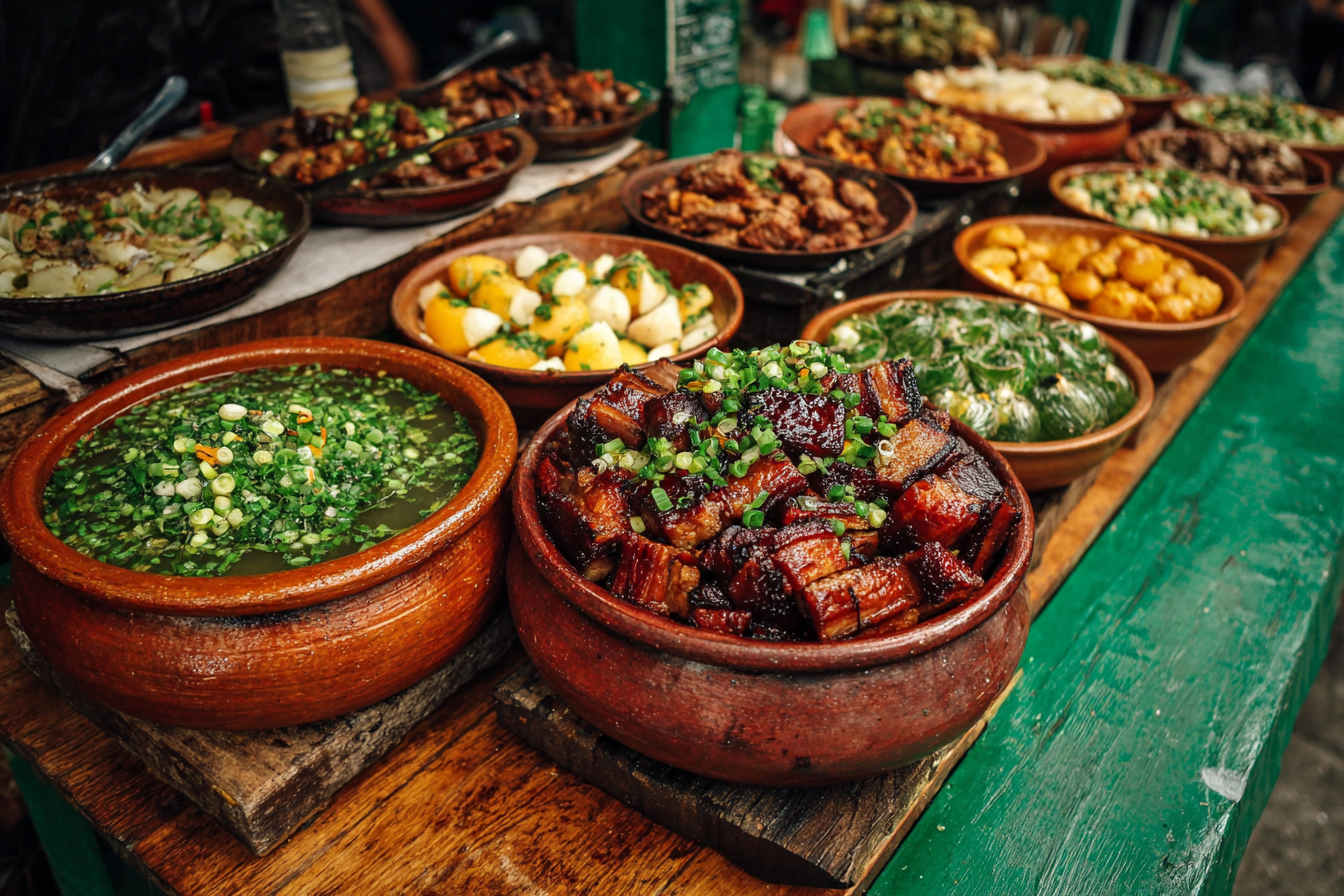Filipino cuisine is a vibrant tapestry of flavors, colors, and traditions that reflect the diverse history and culture of the Philippines. From tangy and savory to sweet and spicy, the food here offers something for every palate. Whether you’re a first-time visitor or a seasoned traveler, exploring Filipino food is like embarking on a delicious journey through each region’s unique heritage. In this guide, we’ll delve into the must-try dishes, iconic street foods, top places to eat, and essential tips for food lovers eager to experience authentic Filipino flavors firsthand.
Popular Dishes and Regional Specialties
The Philippines boasts an impressive variety of dishes, many of which have been influenced by Malay, Spanish, Chinese, and American cuisines. Each region puts its own twist on traditional recipes, making Filipino food culture incredibly diverse.
One of the most famous Filipino dishes is Adobo, a savory stew typically made with pork or chicken, marinated in vinegar, soy sauce, garlic, and spices. It’s loved nationwide and considered the unofficial national dish. Another staple is Sinigang, a sour tamarind-based soup filled with pork, shrimp, or fish alongside fresh vegetables. Its tangy and refreshing flavor profile is perfect for warm tropical days.
In the Visayas, the island of Cebu is famous for its Lechon — a roasted whole pig with crispy skin, often served during celebrations but also found in many local eateries. Meanwhile, the Ilocos region in Luzon features Vigan Longganisa, a garlicky sausage with a slightly sweet taste, which is distinctively different from other Filipino sausages.
Don’t miss Kare-Kare, a creamy peanut sauce stew filled with oxtail, tripe, and vegetables, best enjoyed with a side of fermented shrimp paste called bagoong. And for a hearty breakfast, try Tapsilog, a plate with cured beef (tapa), garlic fried rice (sinangag), and a fried egg.
Street Food Culture and Safety Tips
One of the best ways to experience Filipino cuisine is through its vibrant street food culture. From bustling night markets to seaside stalls, street vendors offer a variety of quick and affordable bites. Common street eats include Isaw (grilled chicken or pork intestines), Kwek-Kwek (quail eggs coated in orange batter and deep-fried), and Balut (a boiled fertilized duck egg), which adventurous travelers often try.
Street food also includes sweet treats like Turon (banana and jackfruit wrapped in spring roll wrapper and fried), Puto (steamed rice cakes), and Halo-Halo, a colorful dessert made of crushed ice, sweet beans, fruits, jellies, and evaporated milk.
While street food is a must-try, it’s essential to keep safety in mind. Here are some tips:
- Choose vendors with high turnover to ensure freshness.
- Buy food that is cooked fresh in front of you or that is served hot.
- Avoid raw or undercooked items unless you trust the hygiene standards.
- Carry hand sanitizer and wash your hands before eating.
- Stay hydrated and avoid street food during peak heat or rainy seasons to reduce the risk of foodborne illness.
Best Food Markets and Restaurants
To taste a wide range of Filipino dishes in one spot, visiting local markets and specialty restaurants is a must. In Manila, Salcedo Saturday Market and Legazpi Sunday Market feature food stalls with both traditional and modern Filipino fare, perfect for sampling artisanal products and street food all at once.
For a more immersive experience, head to Carlo’s Lechon in Cebu, revered for its mouthwatering roasted pig. In Pampanga, renowned as the culinary capital of the Philippines, try restaurants like Everybody’s Café serving authentic Kapampangan delicacies such as sisig (sizzling chopped pig’s head and liver)
If you prefer upscale dining, Metro Manila offers restaurants like Abe and Bistro Remedios, where dishes represent Filipino heritage prepared with refined techniques and quality ingredients. For a casual but equally good option, neighborhood eateries called carinderias serve home-style cooking at very affordable prices.
Food Festivals in the Philippines
Food festivals are fantastic opportunities to dive deep into Filipino cuisine while celebrating culture and community. Some of the most popular festivals include:
- Dinagyang Festival in Iloilo – Featuring vibrant street dances, this festival also highlights Ilonggo culinary specialties during the event.
- MassKara Festival in Bacolod – Known for its joyful masks and performances, you can also feast on Inasal (grilled chicken marinated in local spices).
- Pahiyas Festival in Lucban, Quezon – Although famous for its colorful decorations, the festival is also a showcase of regional delicacies like kiping (rice wafers) and fresh produce.
- Sinulog Festival in Cebu – Alongside traditional dances, food stalls fill the streets offering a variety of Cebuano dishes.
Vegetarian and Dietary Considerations
Though Filipino food traditionally incorporates lots of meat and seafood, there are plenty of options for vegetarians and those with dietary restrictions. Many vegetable-based dishes and snacks are available such as pinakbet (mixed vegetable stew with shrimp paste; however, you can request a version without it), ginataang gulay (vegetables cooked in coconut milk), and fresh tropical fruits that abound across the islands.
Filipino cuisine also features rice as a staple, which is naturally gluten-free, and many dishes use coconut milk or vinegar, making them suitable for different dietary needs. For vegan travelers, it’s helpful to communicate with restaurant staff as many sauces like fish sauce or oyster sauce are common in traditional recipes but can often be substituted.
Tips for Food Lovers Traveling in the Philippines
To make the most out of your Filipino food adventure, here are some practical tips:
- Be adventurous: Don’t hesitate to try unfamiliar dishes or street food, as Filipino cuisine offers unique combinations and flavors you won’t find elsewhere.
- Eat local: Choose restaurants or stalls popular among locals for the most authentic experience.
- Timing matters: Some specialties like lechon or market goods are best enjoyed fresh in the morning or during fiesta days.
- Use apps and ask locals: Apps like Zomato or Google Maps can help you locate highly rated eateries, but don’t underestimate locals’ recommendations—they often know hidden gems.
- Stay hydrated and pace yourself: Filipino food is richly flavored and can be heavy; drink lots of water and savor meals slowly to enjoy every bite.
Exploring the Philippines through its food is an unforgettable experience that opens doors to the country’s culture and hospitality. Whether savoring a steaming bowl of sinigang in a seaside town, biting into grilled street skewers at night, or indulging in festive sweets during a local celebration, Filipino cuisine offers a truly welcoming taste of the islands.







